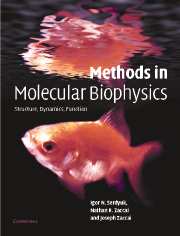Book contents
- Frontmatter
- Contents
- Foreword by D. M. Engelman
- Foreword by Pierre Joliot
- Preface
- Introduction: Molecular biophysics at the beginning of the twenty-first century: from ensemble measurements to single-molecule detection
- Part A Biological macromolecules and physical tools
- Part B Mass spectrometry
- Part C Thermodynamics
- Part D Hydrodynamics
- Part E Optical spectroscopy
- Part F Optical microscopy
- Part G X-ray and neutron diffraction
- Part H Electron diffraction
- Part I Molecular dynamics
- Part J Nuclear magnetic resonance
- References
- Index of eminent scientists
- Subject Index
Foreword by D. M. Engelman
Published online by Cambridge University Press: 05 November 2012
- Frontmatter
- Contents
- Foreword by D. M. Engelman
- Foreword by Pierre Joliot
- Preface
- Introduction: Molecular biophysics at the beginning of the twenty-first century: from ensemble measurements to single-molecule detection
- Part A Biological macromolecules and physical tools
- Part B Mass spectrometry
- Part C Thermodynamics
- Part D Hydrodynamics
- Part E Optical spectroscopy
- Part F Optical microscopy
- Part G X-ray and neutron diffraction
- Part H Electron diffraction
- Part I Molecular dynamics
- Part J Nuclear magnetic resonance
- References
- Index of eminent scientists
- Subject Index
Summary
It might be thought that this book is about methods, and, as is often supposed, that the field of biophysics is defined as a collection of such methods. But, as is carefully developed in the text, there is a deeper significance – methods define what we (provisionally) know about the world of biological molecules, and biophysics is a field that integrates pieces of information to give substance to our explanations of biology in terms of macromolecular space and time: structure, interactions and dynamics. Two interrelated ideas that biophysicists employ are the structure–function hypothesis and evolution.
The structure–function hypothesis is crisply discussed in the lucid introduction to the book: the idea is that each macromolecule coded by the genome has a function, and that the function can be understood using the chemical structure, interactions and dynamics of the macromolecule. Evolution forms the foundation of this reductionist view, since functionality is the basis of natural selection. Thus, biophysical methods teach us, within the limits of the information they give, about function and evolution. A particular hope, which has been rewarded with a great deal of success, is that understanding particular cases will lead to generalising ideas – base pairing in nucleic acids, oxygen binding by haem, self-association of lipids to create bounded compartments, for example.
A book that teaches the methods well creates the intellectual framework of our understanding, and can guide the field.
Information
- Type
- Chapter
- Information
- Methods in Molecular BiophysicsStructure, Dynamics, Function, pp. xi - xiiPublisher: Cambridge University PressPrint publication year: 2007
